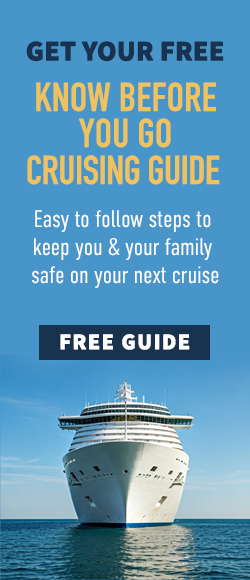July 7, 2015
G.B., vs CARNIVAL CORPORATION,
Summary
The maritime attorneys at Lipcon, Margulies & Winkleman, P.A. filed a lawsuit on behalf of a passenger who was injured when another passenger was improperly sliding in the Waterworks area of the Carnival cruise ship, causing her to fall and sustained severe injuries. The attorneys sued Carnival alleging a lack of lifeguards in the area, and a lack of crewmembers supervising, monitoring and/or controlling the passengers’ activities in the area. Carnival filed a motion to dismiss the lawsuit, and this is the response to Carnival’s motion. Ultimately, the Court denied Carnival’s motion and allowed the case to proceed.
UNITED STATES DISTRICT COURT
SOUTHERN DISTRICT OF FLORIDA
MIAMI DIVISION
IN ADMIRALTY
CASE NO. 15-22103-CV-GAYLES/TURNOFF
G.B.,
Plaintiff,
v.
CARNIVAL CORPORATION,
Defendant.
/
PLAINTIFF’S RESPONSE IN OPPOSITION TO
DEFENDANT’S MOTION TO DISMISS COMPLAINT
The Plaintiff, G.B., by and through undersigned counsel and pursuant to Federal Rules of Civil Procedure, hereby responds in opposition to Defendant, CARNIVAL CORPORATION’S (“Carnival[’s]”) Motion to Dismiss Complaint [D.E. 6] and, in furtherance thereof, states as follows:
I. Introduction
The instant matter arises out of the personal injuries the Plaintiff sustained during a Carnival cruise. Specifically, the Plaintiff alleges that on August 9, 2014, she suffered severe injuries when another passenger, who was sliding in the Waterworks area of the ship, ran into her and caused her to fall. [D.E. 1].
As a result thereof, on June 6, 2015, the Plaintiff initiated this lawsuit alleging Carnival’s negligence. [D.E. 1]. At issue herein is Carnival’s Motion to Dismiss, wherein Carnival argues that Plaintiff’s Complaint should be dismissed for failure to state a claim. [D.E. 6]. As set forth in detail below, however, the Plaintiff’s Complaint properly and succinctly states a claim for negligence that sets forth the Plaintiff’s entitlement to relief with sufficient factual allegations in support of the claim. Accordingly, Carnival’s Motion to Dismiss should be denied its entirety.
II. Standard for Motions to Dismiss for Failure to State a Claim
A motion to dismiss for failure to state a claim merely tests the sufficiency of the complaint; it does not decide the merits of the case. Milburn v. United States, 734 F.2d 762, 765 (11th Cir. 1984). When considering such a motion, a court must accept the allegations in the plaintiff’s complaint as true and construe them in the light most favorable to the plaintiff. Ashcroft v. Iqbal, 556 U.S. 662, 678 (2009); see also Lobo v. Celebrity Cruises, Inc., 704 F.3d 882, 887 (11th Cir. 2013).
In order to state a claim, Federal Rule of Civil Procedure 8 requires “a short and plain statement of the claim showing that the pleader is entitled to relief.” Fed. R. Civ. P. 8(a)(2). The statement need only “give the defendant fair notice of what the… claim is and the grounds upon which it rests.” Bell Atl. Corp. v. Twombly, 550 U.S. 544, 555 (2007).
In sum, “[t]he threshold of sufficiency that a complaint must meet to survive a motion to dismiss for failure to state a claim is exceedingly low.” Bluegreen Corp. v. PC Consulting, Inc., 0780385CIV-RYSKAMP, 2007 WL 2225983 (S.D. Fla. July 31, 2007) (citing In re Southeast Banking Corp., 69 F.3d 1539, 1551 (11th Cir. 1995)) (emphasis added). As such, this Court has routinely stated that such motions are “viewed with disfavor and rarely granted.” Jackson v. BellSouth Telecommunications, Inc., 181 F. Supp. 2d 1345 (S.D. Fla. 2001), aff’d sub nom. Jackson v. BellSouth Telecommunications, 372 F.3d 1250 (11th Cir. 2004) (citation omitted).
In applying the aforementioned standards to the case at bar, it is clear that Carnival’s Motion to Dismiss for failure to state a claim should be denied in its entirety.
III. Argument
It is undisputed that general maritime law applies to this case. [D.E. 1, ¶6, see also D.E. 6, p. 2]. In order to prevail on a maritime negligence claim, a plaintiff must show that: 1) the defendant owed the plaintiff a duty; 2) the defendant breached that duty; 3) the breach was the proximate cause of the plaintiff’s injury; and 4) the plaintiff suffered damages. See Chaparro v. Carnival Corp., 693 F.3d 1333, 1336 (11th Cir. 2012) (internal citation omitted); see also Hasenfus v. Secord, 962 F.2d 1556, 1559‐60 (11th Cir. 1992) (citing Florida law).
It is well established that under federal maritime law, a cruise ship owes its passengers a duty of reasonable care under the circumstances. See Keefe v. Bahama Cruise Line, Inc., 867 F.2d 1318, 1322 (11th Cir. 1989); see also Kemarec v. Compagnie Generale Transatlantique, 358 U.S. 625, 632 (1959). This standard requires that the cruise line have “actual or constructive notice of the risk‐creating condition” at issue, at least where “the menace is one commonly encountered on land and not clearly linked to nautical adventure.” Keefe, 867 F.2d 1318, 1322 (11th Cir. 1989).
In its Motion to Dismiss, Carnival argues that the Plaintiff’s negligence claim should be dismissed for the following reasons: A) failing to plead facts as to how the Plaintiff’s injury was caused by the alleged failures of Carnival; B) failing to plead actual or constructive knowledge; and, C) improperly creating a duty under the International Safety Management Code. As detailed below, however, all of these arguments fail.
A. The Plaintiff’s Complaint properly and succinctly sets forth detailed factual allegations as to how the incident occurred due to Carnival’s negligence.
Carnival argues that the Plaintiff’s Complaint should be dismissed because “Plaintiff does not allege any facts that demonstrate how the alleged failures listed in the [C]omplaint’s paragraph 13 resulted in her accident.” [D.E. 6, p. 5].
Contrary to that argument, however, the Complaint alleges sufficient factual allegations to support the Plaintiff’s negligence claim. For instance, paragraph 10 states that the “Plaintiff was severely injured when another passenger was sliding in the waterworks area of the ship and ran into her causing her to fall to the deck.” [D.E. 1, ¶10] (emphasis added). Paragraph 13 goes on to describe, in specific details, the ways in which Carnival breached its duty to provide reasonable care, including the following omissions:
a. Failure to have lifeguards and/or adequate crew supervising and controlling passenger activity in Waterworks area; and/or
b. Failure to promulgate and/or enforce adequate rules and procedures for controlling passenger activity in Waterworks area[1]; and/or
c. Failure to warn Plaintiff and other passengers of dangers of passenger activity in Waterworks area; and/or
d. Failure to have safe places to stand in Waterworks area where Plaintiff and other passengers would be safe from passenger activity; and/or
e. Failure to adequately communicate rules and procedures for controlling passenger activity in Waterworks area; and/or
f. Overservice of alcohol to passengers; and/or
g. Failure to adequately monitor passenger activity in Waterworks area; and/or
h. Failure to adequately control passenger activity in Waterworks area; and/or
[1] Carnival seeks to have this particular allegation dismissed, arguing that it is a “conclusory statement” [D.E. 6, p. 6]. As stated in Caldwell v. Carnival Corp., 944 F. Supp. 2d 1219 (S.D. Fla. 2013), even though “certain of the alleged breaches… may not adequately state a negligence claim, the Court will not strike the alleged breaches in line-item fashion” when the plaintiff sufficiently alleges a facially plausible negligence claim, as the Plaintiff has herein. Id. at 1224.
i. Failure to have adequate handgrabs in Waterworks area; and/or
j. Creating an area where passengers are likely to slide on the deck; and/or
k. Failure to warn Plaintiff and other passengers of likelihood of other passengers sliding on the deck in the Waterworks area; and/or
l. Failure to respond adequately to prior similar incidents and take corrective measure; and/or
m. Failure to warn Plaintiff and other passengers of prior similar incidents; and/or
n. Failure to promulgate and/or enforce adequate policies and procedures to ensure that passengers like the Plaintiff are warned of the dangers posed by passenger activity in the Waterworks area…
[D.E. 1, ¶13].
Thereafter, the Complaint specifically alleges that “all or some” of the omissions listed in paragraph 13 “caused and/or contributed to another passenger sliding on the deck in the Waterworks area into the Plaintiff, causing her to fall.” [D.E. 1, ¶13]. It is therefore axiomatic that the identified hazard (i.e., another passenger sliding in the waterworks area of the ship) is alleged to have caused the Plaintiff’s fall and subsequent injury due to, inter alia, the lack of lifeguards in the area, and the lack of crewmembers supervising, monitoring and/or controlling the passengers’ activities in the area. [D.E. 1, ¶13(a), (g)-(h)].
These allegations provide Carnival with notice of what the Plaintiff’s claim is about and, at the very least, are sufficient to draw a reasonable inference of negligence. See Prokopenko v. Royal Caribbean Cruise Ltd., No. 10‐20068, 2010 WL 1524546, at **1‐2 (S.D. Fla. Apr. 15, 2010) (allegation that plaintiff “was caused to fall on water on deck of the ship at or near the swimming pool, causing her serious injury” was “sufficient to draw a reasonable inference of negligence” under Ashcroft). Further, accepting the Plaintiff’s allegations as true and construing them in the light most favorable to the Plaintiff, the allegations nudge the negligence count “across the line from conceivable to plausible,” which is all that is required under Twombly.
B. The Plaintiff’s Complaint adequately pleads Carnival’s actual or constructive knowledge of the alleged dangerous condition (i.e., passengers sliding in the area), including prior similar accidents.
Next, Carnival argues that the Plaintiff “failed to adequately plead that Carnival had actual or constructive knowledge of the alleged undefined hazard” and that the Plaintiff failed to plead “allegations of prior injuries or of safety concerns that would have put Carnival on notice of the claimed dangerous condition triggering a duty to warn.” [D.E. 6, p. 5].
In direct contrast to Carnival’s argument, however, the Plaintiff did in fact allege that there were prior similar incidents. Specifically, the Plaintiff alleged that Carnival failed to “respond adequately to prior similar incidents and take corrective measure,” and it failed to “warn Plaintiff and other passengers of prior similar incidents. [D.E. 1, ¶13(l)-(m)]. The Complaint also explicitly alleges actual or constructive knowledge in paragraph 14, which states that Carnival “knew of the foregoing conditions causing Plaintiff’s accident and did not correct them, or the conditions existed for a sufficient length of time so that Defendant in the exercise of reasonable care under the circumstances should have learned of them and corrected them.” [D.E. 1, ¶¶32-33].
Ultimately, the Plaintiff is not required to plead evidence, nor is she required to plead every single fact upon which her claim is based. See Gentry v. Carnival Corp., 11-21580-CIV, 2011 WL 4737062 (S.D. Fla. 2011) (“[plaintiff] is not required to plead evidence, nor even all the facts upon which her claim is based”). It is only necessary that the allegations in the complaint “raise a reasonable expectation that discovery will reveal evidence” corroborating the Plaintiff’s claim (Twombly, 550 U.S. at 556, 570), and the above allegations meet such standard. Addressing this point in Ash v. Royal Caribbean Cruises Ltd., No. 13-20619-CIV, 2014 WL 6682514, at *6 (S.D. Fla. Nov. 25, 2014), the Court made the following statement, which is particularly applicable herein:
As a practical matter, a personal injury plaintiff is often unaware of specific facts demonstrating that the defendant knew or should have known of a dangerous condition at the time the lawsuit is filed, before taking discovery. Plaintiffs sometimes obtain evidence of the defendant’s knowledge during discovery, such as by obtaining evidence that the defendant was aware of prior injuries occurring under similar circumstances.
Ash, 2014 WL 6682514, at *6
Based on the foregoing, it is clear that the Plaintiff sufficiently alleged Carnival’s actual or constructive knowledge of the dangerous condition, including previous similar incidents.
C. The Plaintiff correctly pleads Carnival’s duty to exercise reasonable care without expanding the duties imposed by law, and she simply refers to the ISM Code as support that Carnival breached its duty.
Carnival’s last argument for dismissal is that the Plaintiff “improperly attempts to create a duty under the International Safety Management [“ISM”] Code that does not exist.” [D.E. 6, p. 6.].
As a brief form of background, the ISM Code was drafted by the International Maritime Organization (a United Nations body), and it provides an international standard for the safe management and operation of ships to ensure safety at sea and prevent human injury or loss of life. See ISM Code, § 1.2. The Code mandates written documentation of a comprehensive safety and environmental program (Safety Management Plan), including training and internal auditing, and extends the traceable chain of responsibility for safety straight to the top of management.[2] As a signatory to the 1974 SOLAS Convention and the amendatory 1978 protocol, the United States is bound to enforce the ISM Code for vessels flying the United States flag as well as foreign vessels calling at U.S. ports. Id. In fact, Congress enacted legislation to incorporate the Code into the laws of the United States. See 46 U.S.C. §§ 3201-3205 (2010).[3]
It is therefore undisputed that the ISM Code applies to the subject vessel, the Carnival Sensation, which calls at U.S. ports. Considering that Carnival was required to follow these regulations, the Plaintiff maintains that any evidence that Carnival failed to follow them is evidence that they failed to act reasonably under the circumstances. Accordingly, the Plaintiff refers to the ISM Code within the negligence count to further explain how Carnival breached the duty of reasonable care owed to the Plaintiff (i.e., by “violat[ing] the International Safety Management Code and fail[ing] to have a proper, adequate and safe Safety Management System Manual (SQM) and/or fail[ing] to follow their SQM manual.” [D.E. 1, ¶14]). This allegation is not pled as a separate duty nor is it the only basis of Plaintiff’s negligence claim – it is merely included as further support of such claim.
The case cited by Carnival, Calderon v. Reederie Claus-Peter Offen, 2009 WL 3429771 (S.D. Fla. 2009), is therefore inapposite. While Calderon prohibits a seafarer from bringing a separate and independent cause of action under the ISM Code, it does not prohibit the use of the ISM Code in allegations supporting a defendant’s negligence. In fact, this Court has previously rejected a cruise line’s identical challenge. See Gentry, 2011 WL 4737062 (“the fact that [plaintiff] alleged an additional basis for Carnival’s duty predicated on the ISM is not relevant for deciding this motion to dismiss”).
Accordingly, contrary to Carnival’s argument, the Plaintiff properly refers to the ISM Code as support that Carnival breached its duty (along with other alleged negligent acts and/or omissions discussed above) without expanding the duties imposed by law.
IV. Motion for Leave to Amend
Should this Honorable Court grant Carnival’s motion or any portion thereof, the Plaintiff respectfully requests leave to amend.
WHEREFORE, for the foregoing reasons, the Plaintiff respectfully requests that this Honorable Court enter an Order denying Carnival’s Motion to Dismiss Complaint [D.E. 6], and any further relief this Court deems just and proper.
Respectfully submitted,
LIPCON, MARGULIES,
ALSINA & WINKLEMAN, P.A.
Attorneys for Plaintiff
One Biscayne Tower, Suite 1776
2 South Biscayne Boulevard
Miami, Florida 33131
Telephone No.: (305) 373-3016
Facsimile No.: (305) 373-6204
By: /s/ Jacqueline Garcell
JASON R. MARGULIES
Florida Bar No. 57916
JACQUELINE GARCELL
Florida Bar No. 104358
[CERTIFICATE OF SERVICE AND SERVICE LIST ON THE FOLLOWING PAGE]
CERTIFICATE OF SERVICE
I HEREBY CERTIFY that on July 7, 2015, I electronically filed the foregoing document with the Clerk of the Court using CM/ECF. I also certify that the foregoing document is being served this day on all counsel of record or pro se parties identified on the attached Service List in the manner specified, either via transmission of Notices of Electronic Filing generated by CM/ECF or in some other authorized manner for those counsel or parties who are not authorized to electronically receive Notices of Electronic Filing.
By: /s/ Jacqueline Garcell
JACQUELINE GARCELL
[1] Carnival seeks to have this particular allegation dismissed, arguing that it is a “conclusory statement” [D.E. 6, p. 6]. As stated in Caldwell v. Carnival Corp., 944 F. Supp. 2d 1219 (S.D. Fla. 2013), even though “certain of the alleged breaches… may not adequately state a negligence claim, the Court will not strike the alleged breaches in line-item fashion” when the plaintiff sufficiently alleges a facially plausible negligence claim, as the Plaintiff has herein. Id. at 1224.
[2] This documentation creates a paper trail of a company’s compliance (or non-compliance), and gives rise to share responsibility for all those in the company’s chain of command. See The International Safety Management (ISM) Code: A New Level of Uniformity, 37 Tul. L. Rev. 1585 (1999).
[3] For instance, § 3204(a) provides that each responsible [ship-owner] must establish and submit to [the Coast Guard] for approval a safety management plan describing how that entity and vessels of the entity comply with the regulations under the ISM Code. Section 3205(c), further provides that the Coast Guard will “periodically review whether a responsible [ship-owner] is complying with the safety management plan.” Finally, the ISM Code requires each ship to “establish and implement against all identified risk,” 33 C.F.R. § 96.230(b), and to have a detailed “written manual that outlines a Safety Management System.”








